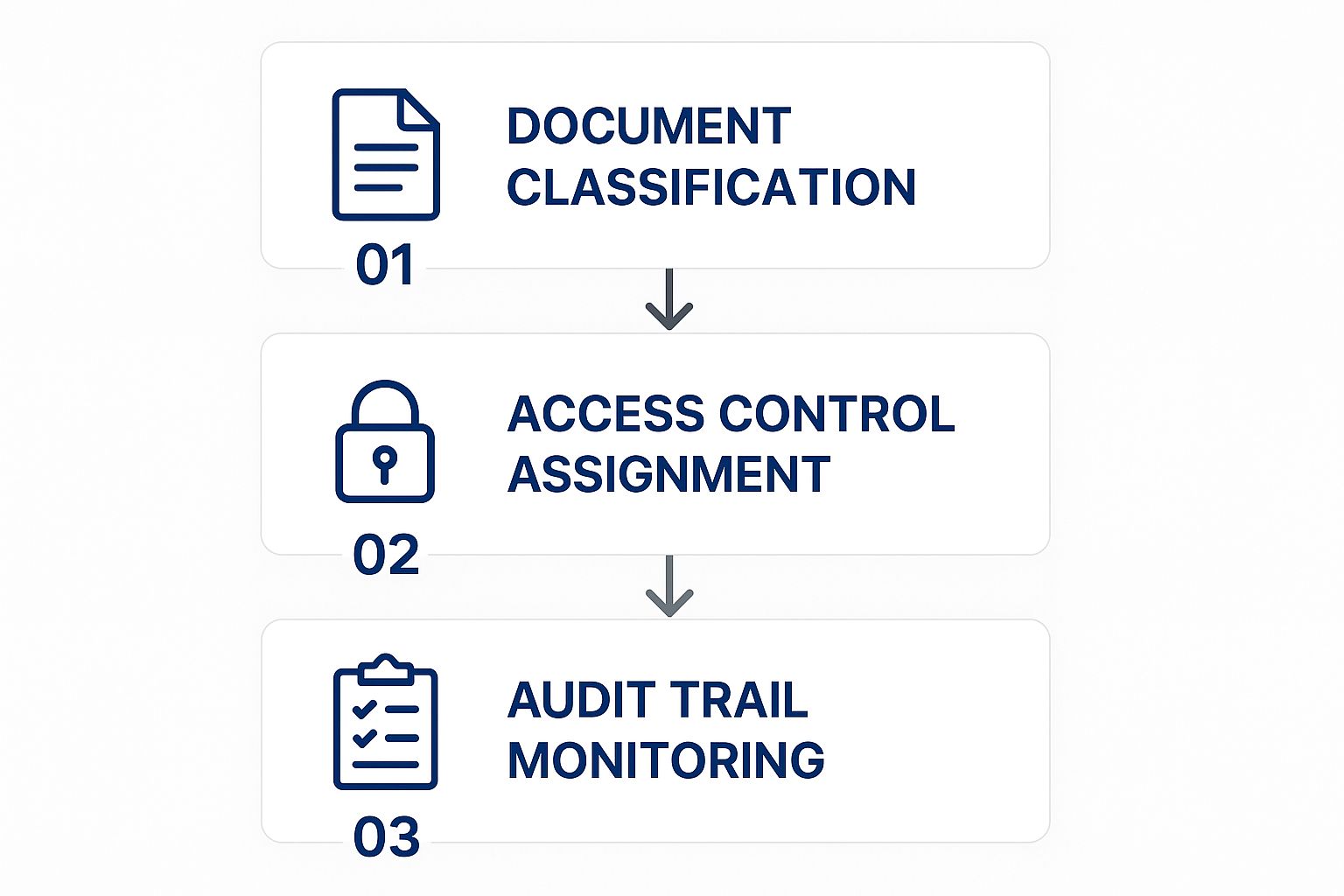Small Business Document Management: Boost Efficiency & Security
Let's be honest—that mountain of invoices, cluttered server, and chaotic desktop isn't just messy. It's expensive.
Think of it as a warehouse with no inventory system. Every minute your team spends searching for a lost contract or the correct version of a proposal is a direct hit to your bottom line.
Why Disorganized Files Are Costing Your Business Money

The hidden costs of poor file organization go way beyond simple frustration. These expenses quietly drain your resources, chipping away at productivity, security, and even your ability to grow.
Every time an employee asks, "Where's the latest version of that client agreement?" or spends fifteen minutes digging through shared folders for a specific invoice, that’s payroll being spent on non-productive work. This wasted time adds up fast across a team, turning into hundreds of lost hours every single year.
The Tangible Costs of Chaos
It might sound old-fashioned, but this is a surprisingly common problem. A shocking 45% of SMBs still rely mainly on paper records for document storage. That practice alone introduces significant physical storage costs and the constant risk of misplacing critical files.
The dangers, however, extend far beyond simple inefficiency. The real risks include:
- Compliance Failures: Mismanaging sensitive customer data or financial records can lead to steep fines and serious legal trouble.
- Security Vulnerabilities: Unstructured digital files and physical papers are easy targets for data breaches. You can dive deeper into protecting your information in our guide to document management security.
- Poor Decision-Making: When you can't find accurate, up-to-date information, you can't make informed strategic choices for your business.
The core issue is that disorganized files create friction in every corner of your business. From sales to accounting, this chaos slows down operations and prevents your team from focusing on what truly matters—serving customers and driving growth.
To get to the root of the problem, you need a system. If you learn how to organize business documents effectively, you can transform that chaos into clarity. Adopting a clear system isn't just about being tidy; it's a fundamental business strategy for reclaiming control and boosting your bottom line.
What Is a Document Management System Anyway?
Let's cut through the tech-speak. The easiest way to think about it is to imagine hiring the perfect digital librarian for your business. This librarian works around the clock, never loses a single file, and can pull up any document you need in seconds. That's essentially what a document management for small business solution does.
A Document Management System (DMS) is far more than just another folder on your computer. It’s an intelligent, centralized hub built to manage the entire lifecycle of your company’s information, from creation to archival. To really get it, let's break its job down into three powerful actions.
Capture, Centralize, and Control
At its heart, a DMS brings order to chaos by performing three core functions:
- Capture: It effortlessly pulls documents in from anywhere. Think scanned paper invoices, saved email attachments, or imported digital files like contracts and project plans.
- Centralize: All those documents land in one secure, unified place. This puts an end to the frustrating scavenger hunts across different desktops, email inboxes, and chaotic shared drives. It creates a single source of truth.
- Control: The system gives you granular command over who can view, edit, or share files. It also tracks every version of a document, so you can be confident you’re always working with the latest one.
This systematic approach is precisely why the global market for these systems is booming. It was valued at $8.96 billion** recently and is projected to skyrocket to **$17.03 billion by 2029. Businesses everywhere are recognizing the critical need for digital efficiency and security.
A DMS transforms your documents from static, isolated files into active, manageable assets. It’s the difference between a cluttered desk piled high with paperwork and a perfectly organized digital library where everything is at your fingertips.
This shift from manual disarray to automated order is fundamental. To see just how different the two worlds are, let's compare them side-by-side.
Manual vs. Digital Document Management at a Glance
This table clearly illustrates the operational differences between a traditional paper-based system and a modern digital approach.
| Feature | Manual Paper System | Digital Management System (DMS) |
|---|---|---|
| Accessibility | Limited to physical office location and hours | 24/7 access from anywhere with an internet connection |
| Search & Retrieval | Slow, manual search through filing cabinets | Instant keyword search finds documents in seconds |
| Security | Vulnerable to fire, theft, flood, and misfiling | Encrypted, backed up, with access controls and audit trails |
| Collaboration | Difficult; requires copying and physical sharing | Real-time collaboration and seamless version control |
| Cost | High costs for printing, storage, and staff time | Lower operational costs and improved productivity |
| Compliance & Audits | A time-consuming, stressful, and error-prone process | Simplified and streamlined with organized, traceable data |
The contrast is stark. One method is stuck in the past, creating bottlenecks and risk, while the other paves the way for a more agile and secure business.
If you’re ready to dive deeper into the nuts and bolts, a comprehensive guide to understanding Document Management Systems is a great resource. You can also read our detailed breakdown of how a document management system can specifically benefit your operations. Ultimately, it’s about swapping costly, time-consuming disorganization for a smart process that helps your business grow.
How a DMS Directly Impacts Your Bottom Line

Putting a document management system (DMS) in place isn't just about tidying up your digital files. It's a strategic business move that delivers real, measurable improvements to your financial health. The core features of a good DMS translate directly into cost savings and productivity boosts that strengthen your bottom line.
Just think about all the time your team wastes simply trying to find information. A recent Harris Poll found that 26% of workers can spend up to five hours a day searching for the data they need to do their jobs. A DMS with a powerful search function hands that wasted time right back to you as productive, billable hours.
This isn't just about efficiency, either. It's about opportunity. A Foundry survey revealed a startling statistic: 58% of businesses have actually lost deals because they couldn't get their hands on critical data quickly enough. With a solid document management solution, your team can pull up contracts, proposals, and client histories instantly, making sure you're always ready to close.
Turning Security Into Savings
Strong security features like encryption and detailed audit trails do more than just help you sleep at night. They're your frontline defense against data breaches, which can come with staggering financial penalties.
A secure system protects your most valuable asset—your information—and saves you from the huge potential costs of fines, legal battles, and a damaged reputation. It's an investment in prevention that pays for itself by heading off enormous risks.
A DMS doesn't just store documents; it transforms them into secure, accessible assets that drive efficiency and protect against financial loss. It's a strategic tool for turning operational chaos into a competitive advantage.
Driving Down Operational Costs
On top of the productivity gains, a DMS actively trims your day-to-day operational expenses. When you shift away from paper-based processes, you’ll see a significant drop in spending on physical supplies.
Here’s a quick look at how the savings add up:
- Reduced Supply Costs: You'll slash your budget for paper, ink, toner, and printer maintenance.
- Eliminated Physical Storage: That office space currently filled with filing cabinets can be repurposed, or you can cancel that expensive off-site storage unit.
- Faster Workflows: Automated processes mean tasks like approving an invoice happen in minutes, not days. Better document workflow management directly speeds up your entire business cycle.
Enhancing Team Collaboration and Agility
In a world of remote and hybrid work, smooth collaboration is non-negotiable. A DMS gets rid of the email chaos where multiple versions of the same document are flying around. With one central place to access files and clear version control, your team is always working on the right draft.
This unified approach prevents expensive mistakes and rework, keeping projects on track and moving forward. It gives your team the power to work together effectively, no matter where they are, turning collaboration into a direct driver of business growth and a clear competitive edge.
What Features Should a Small Business Look For?

When you're shopping for a document management system, it's easy to get overwhelmed. Some platforms are built for huge corporations and are loaded with complex features you'll never touch. The trick is to find a system that gives you exactly what you need to solve today's problems and support tomorrow's growth—without paying for a lot of bells and whistles.
Think of it like buying a delivery van. You don't need a massive semi-truck, just a reliable vehicle that gets the job done efficiently. The same principle applies to document management for small business solutions. Let’s break down the essential features that will actually make a difference for your team.
A Single, Central Hub in the Cloud
At its core, a good DMS gives you a secure, centralized place for all your files. This isn't just another shared folder; it's the single source of truth for your company's information, accessible from anywhere with an internet connection.
For a small business, this is a game-changer. It means your team can stay productive whether they're at the office, working from home, or on-site with a client. If you're looking to understand the technology better, it's worth exploring the top cloud storage solutions for small businesses to see what makes them secure and affordable.
OCR and Smart Search That Actually Works
Picture this: you need to find a specific clause in a 50-page scanned contract from three years ago. Instead of reading through the whole thing, you just type a few keywords and find it in seconds. That's the magic of Optical Character Recognition (OCR) paired with a powerful search engine.
OCR technology essentially "reads" your scanned documents and image-based PDFs, turning them into text-searchable files. This simple feature transforms your entire digital filing cabinet—from old invoices to scribbled meeting notes—into an intelligent database, saving you countless hours of frustrating manual searches.
Must-Have Security and Access Controls
Beyond just storing and finding files, you need to be able to control them. The right security features protect your sensitive information and prevent the kind of simple mistakes that can turn into big problems.
- Version Control: This is your safety net. It automatically tracks every change made to a document, showing you who changed it and when. If someone accidentally deletes a critical paragraph, you can restore a previous version instantly. No more "final_v2_final_final.docx" chaos.
- Granular Access Permissions: Not everyone on your team needs access to everything. Granular permissions let you decide, on a file-by-file or folder-by-folder basis, who can view, edit, or share information. This is absolutely critical for protecting things like client data, company financials, and employee records.
For small businesses, these control features aren't about creating red tape. They're about empowering your team to work securely and efficiently, ensuring the right people have the right information when they need it.
Smart Integrations with Your Other Tools
Finally, a document management system shouldn't be a silo. To be truly effective, it has to play nicely with the other software you rely on every day, whether that's your accounting platform, CRM, or project management tool.
Good integrations create a connected work environment where information flows freely between your apps. This means less manual data entry and more cohesive workflows, making your entire business run more smoothly. Pairing these features with smart processes is the key to success. For a deeper dive, check out our guide on document management best practices.
Your Step-by-Step Plan to Go Digital
Making the leap to a digital system can feel like a huge undertaking. I've seen many small business owners get overwhelmed by the thought of it. But if you break it down into a few practical steps, the whole process becomes much more manageable and, frankly, a lot less scary.
Think of it like building a house. You wouldn't just start nailing boards together without a blueprint. A clear plan is what makes sure your document management for small business strategy actually works right from the start.
1. Audit Your Current Documents
First things first, you need to know what you’re working with. Before you can organize a single file, you have to take inventory. This means peeking into those old metal filing cabinets, digging through shared network drives, and yes, even checking the desktops of individual employees.
Your goal here is simple: get a feel for the types of documents that keep your business running. We're talking invoices, client contracts, HR records, marketing flyers—the whole lot. This audit is fantastic for spotting duplicates, identifying obsolete files, and flagging the absolutely essential documents that need to be moved over first.
2. Design Your Digital Structure
Once you have a clear picture of all your documents, it's time to design your new digital filing cabinet. This is where you create a folder structure that actually makes sense for how your business operates. Will you sort everything by client name? By project? Maybe by year or by department?
There's no single "correct" answer here, but I've found a good rule of thumb is to start broad and then get specific. For example, create main folders like "Finance," "Clients," and "HR," and then build out logical subfolders within each. A well-thought-out structure should feel intuitive, so your team can file and find what they need without a second thought.
This is also the perfect time to think about security—classifying your documents, deciding who gets access to what, and setting up ways to monitor activity.

The real takeaway here is that security isn’t a one-and-done task. It's an ongoing process that keeps your sensitive information safe as your business grows and changes.
3. Digitize and Train Your Team
Alright, now for the hands-on part. It's time to start digitizing your paper files. My advice? Don't try to scan every single piece of paper you own on day one. Start with the documents that are most critical to your daily operations or the ones you access most frequently. Pairing this effort with tools like document automation software can seriously speed things up.
But here’s the most important piece of the puzzle: training. A shiny new system is worthless if your team doesn't know how to use it. You have to get everyone in a room (or on a call) and walk them through it. Show them the new folder structure, demonstrate how to upload and search for files, and clearly explain the new rules.
This step is what makes the change stick. When everyone is on the same page and using the system correctly from the get-go, you prevent the team from sliding back into old, chaotic habits. That's how you make your digital transition a true success.
Answering Your Questions About Document Management
Making a switch to a new way of working always brings up some questions. If you're running a small business, you're probably thinking about security, how much it will cost, and whether it’s just another complicated tool your team has to learn. Let's tackle those concerns head-on.
Is My Information Really Safe in the Cloud?
It’s completely normal to worry about storing sensitive client information online. But here’s the thing: modern cloud systems often provide security that’s far more robust than what a small business could build on its own.
Think of it as moving from a locked filing cabinet to a bank vault. Features like end-to-end encryption, strict access controls, and detailed audit trails that log every single action offer layers of protection for your most important data.
These safeguards are non-negotiable. IBM’s 2024 data breach report found that breaches are most common when data is scattered across multiple unsecured places, costing businesses millions. A centralized, secure system is your strongest line of defense.
Will It Be Too Complicated for My Team?
Honestly, the best tools are built with small businesses in mind, which means they’re designed to be easy to use. Most feature intuitive, drag-and-drop interfaces that feel a lot like the cloud storage services you already use, just with more powerful features built for business.
This focus on simplicity means training is minimal. Your team can get up to speed quickly and start seeing a real boost in their productivity right away.
What Does a DMS Actually Cost?
The price tag can vary, but many platforms offer flexible subscription plans that scale with your team size or storage needs. This makes them affordable even for a small shop.
When you look at the cost, it’s crucial to think about the return you're getting. Consider all the time saved, the money you're not spending on paper and printer ink, and the massive value of improved security. A good document management solution for a small business often pays for itself, making it one of the smartest investments you can make for growth.
Ready to stop wrestling with paperwork and start focusing on what really matters? See how Whisperit helps you create and manage documents up to two times faster with secure, AI-powered dictation and editing. Streamline your workflow with Whisperit today.